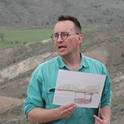Article
Partial Melting to Produce High-Silica Rhyolites of a Young Bimodal Suite: Compositional Constraints Among Rhyolites, Basalts, and Metamorphic Xenoliths from the Harney Basin, Oregon
International Journal of Earth Sciences
(2002)
Abstract
The Rattlesnake Ash Flow Tuff from eastern Oregon includes lithic fragments (xenoliths) of which metasedimentary or metavolcanic lithologies around the vent area in the Harney Basin are samples of the concealed crust. Metasedimentary xenoliths are volcanic lithic to feldspathic graywackes that could be sampling lithologies similar to arc-related terranes to the north that have accreted during Mesozoic time along the Oregon Pacific margin. The importance of finding metaxenoliths in the Rattlesnake Tuff is that they are the first basement samples of southeastern Oregon possibly representative of larger portions of the concealed crust from which voluminous Rattlesnake Tuff and other rhyolites were initially generated during partial melting with subsequent evolution through fractional crystallization. High Ba/Rb ratios of ~30 and La/Yb of ~6.5 of least-evolved Rattlesnake Tuff high-silica rhyolites in combination with other low concentrations of some incompatible trace elements preclude the derivation of least-evolved Rattlesnake Tuff high-silica rhyolite from local low-silica rhyolites through fractionation, which suggests instead that some chemical characteristics could be nearly unmodified signatures derived from partial melting. Rattlesnake metamorphic xenoliths and primitive basalt lavas (HAOT) have the most compatible chemistries as source rock for partial melting among a large range of other local rock compositions. Compositional evidence, comparison with literature data of experimental melts derived from laboratory experiments, and modeling of required effective partition coefficients indicate that least-evolved Rattlesnake Tuff rhyolite was likely generated during dehydration melting of mafic crust at melt percentage ranging from ~5 to 10% with residues as observed in experiments with abundant pyroxene and plagioclase.
Keywords
- Basalts metamorphic,
- Xenoliths,
- Oregon
Disciplines
- Geology and
- Volcanology
Publication Date
August, 2002
Citation Information
Martin J. Streck. "Partial Melting to Produce High-Silica Rhyolites of a Young Bimodal Suite: Compositional Constraints Among Rhyolites, Basalts, and Metamorphic Xenoliths from the Harney Basin, Oregon" International Journal of Earth Sciences Vol. 91 Iss. 4 (2002) Available at: http://works.bepress.com/martin_streck/12/
